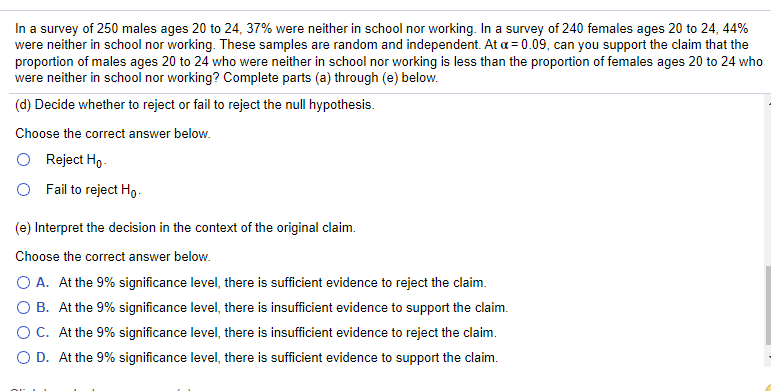In a survey of 250 males ages 20 to 24, 37% were neither in school nor working. In a survey of 240 females ages 20 to 24, 44% were neither in school nor working. These samples are random and independent. At a = 0.09, can you support the claim that the proportion of males ages 20 to 24 who were neither in school nor working is less than the proportion of females ages 20 to 24 who were neither in school nor working? Complete parts (a) through (e) below. (d) Decide whether to reject or fail to reject the null hypothesis. Choose the correct answer below. O Reject Ho- O Fail to reject Ho- (e) Interpret the decision in the context of the original claim. Choose the correct answer below. O A. At the 9% significance level, there is sufficient evidence to reject the claim. O B. At the 9% significance level, there is insufficient evidence to support the claim. OC. At the 9% significance level, there is insufficient evidence to reject the claim. O D. At the 9% significance level, there is sufficient evidence to support the claim.
In a survey of 250 males ages 20 to 24, 37% were neither in school nor working. In a survey of 240 females ages 20 to 24, 44% were neither in school nor working. These samples are random and independent. At a = 0.09, can you support the claim that the proportion of males ages 20 to 24 who were neither in school nor working is less than the proportion of females ages 20 to 24 who were neither in school nor working? Complete parts (a) through (e) below. (d) Decide whether to reject or fail to reject the null hypothesis. Choose the correct answer below. O Reject Ho- O Fail to reject Ho- (e) Interpret the decision in the context of the original claim. Choose the correct answer below. O A. At the 9% significance level, there is sufficient evidence to reject the claim. O B. At the 9% significance level, there is insufficient evidence to support the claim. OC. At the 9% significance level, there is insufficient evidence to reject the claim. O D. At the 9% significance level, there is sufficient evidence to support the claim.
Holt Mcdougal Larson Pre-algebra: Student Edition 2012
1st Edition
ISBN:9780547587776
Author:HOLT MCDOUGAL
Publisher:HOLT MCDOUGAL
Chapter11: Data Analysis And Probability
Section: Chapter Questions
Problem 8CR
Related questions
Question

Transcribed Image Text:In a survey of 250 males ages 20 to 24, 37% were neither in school nor working. In a survey of 240 females ages 20 to 24, 44%
were neither in school nor working. These samples are random and independent. At a = 0.09, can you support the claim that the
proportion of males ages 20 to 24 who were neither in school nor working is less than the proportion of females ages 20 to 24 who
were neither in school nor working? Complete parts (a) through (e) below.
(d) Decide whether to reject or fail to reject the null hypothesis.
Choose the correct answer below.
O Reject Ho.
O Fail to reject Hg-
(e) Interpret the decision in the context of the original claim.
Choose the correct answer below.
O A. At the 9% significance level, there is sufficient evidence to reject the claim.
O B. At the 9% significance level, there is insufficient evidence to support the claim.
OC. At the 9% significance level, there is insufficient evidence to reject the claim.
O D. At the 9% significance level, there is sufficient evidence to support the claim.
Expert Solution
This question has been solved!
Explore an expertly crafted, step-by-step solution for a thorough understanding of key concepts.
This is a popular solution!
Trending now
This is a popular solution!
Step by step
Solved in 2 steps

Knowledge Booster
Learn more about
Need a deep-dive on the concept behind this application? Look no further. Learn more about this topic, statistics and related others by exploring similar questions and additional content below.Recommended textbooks for you

Holt Mcdougal Larson Pre-algebra: Student Edition…
Algebra
ISBN:
9780547587776
Author:
HOLT MCDOUGAL
Publisher:
HOLT MCDOUGAL

College Algebra (MindTap Course List)
Algebra
ISBN:
9781305652231
Author:
R. David Gustafson, Jeff Hughes
Publisher:
Cengage Learning

Holt Mcdougal Larson Pre-algebra: Student Edition…
Algebra
ISBN:
9780547587776
Author:
HOLT MCDOUGAL
Publisher:
HOLT MCDOUGAL

College Algebra (MindTap Course List)
Algebra
ISBN:
9781305652231
Author:
R. David Gustafson, Jeff Hughes
Publisher:
Cengage Learning